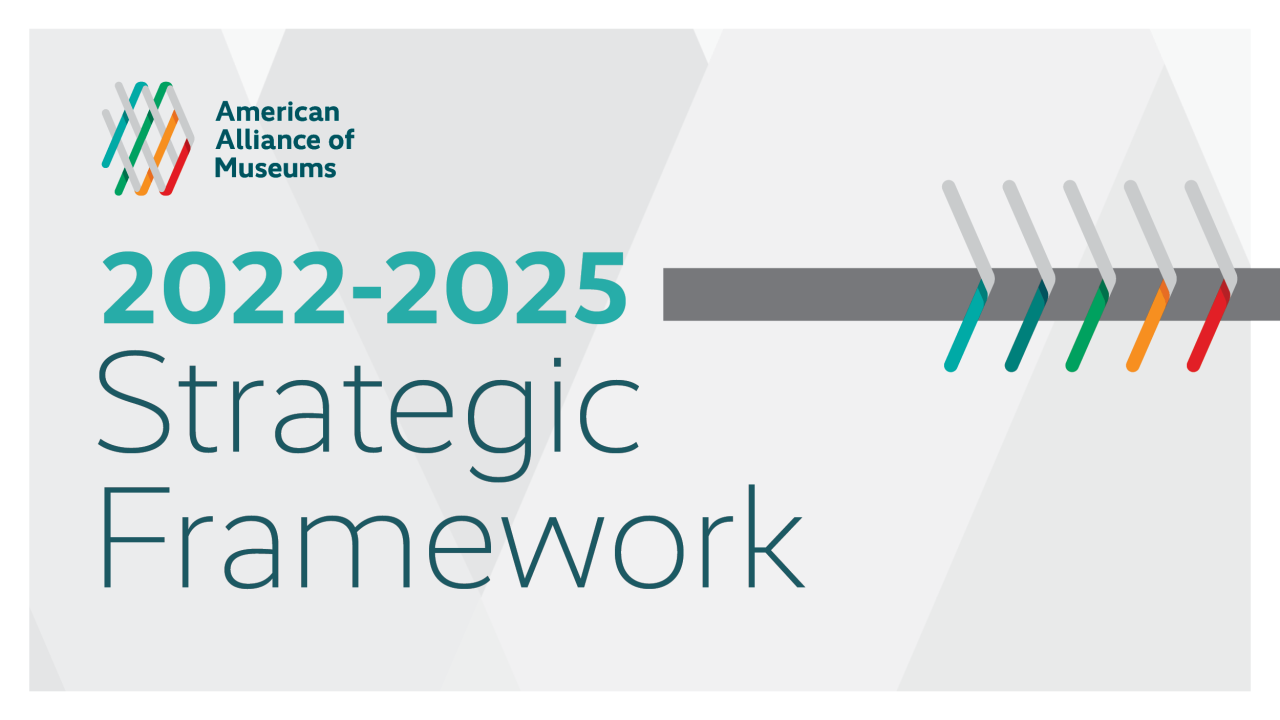
Whether you’re new to the museum field or have been around for decades, you’ve probably noticed that the watchword of this moment is “change.” Our museums, which have conservation in their DNA, are increasingly focused on becoming dynamic, forward-looking organisms.
For all museum professionals in this moment, the challenge is to catch up to social change, and in some cases even lead the way. And as the widest-ranging membership association for the field, our challenge is to support you in that monumental task. With that goal in mind, we initiated our 2022-2025 Strategic Framework, which identifies four areas where we can galvanize change in the field. Now that the first of this four-year period has passed, our team wanted to update you on our progress in these four priority areas: Social & Community Impact, DEAI & Anti-racism, The Museum Community, and The Way We Work. Here’s what we’ve achieved so far and what it means for you!
Social & Community Impact
“The Alliance will advocate for the value of museums, their power to change the world, and their essential roles in sustaining strong, inclusive, and resilient communities by enriching education systems, bolstering economies, strengthening the social fabric of communities, improving peoples’ wellbeing, and beyond.”
In dialogue with partners in the field, we are seeing a growing emphasis on social and community impact: what museums do to benefit their communities and the world. While in theory this has always been an essential question for museums, its importance has become pronounced in recent years. This began with changes in philanthropy, which have pressed museums to re-examine how they define their tangible benefit to the world around them, particularly in matters of justice. Then the pandemic arrived, and museums stepped up to fill critical needs in a more direct way than before, providing an inspiring vision of what was possible.
Skip over related stories to continue reading articleTo build on that momentum, and effectively communicate it to supporters, museums need clear metrics and data on their role as community anchors, such as they do for their role as economic anchors. For that reason, we decided to make investigating and advocating for impact a core priority of our new framework.
As our first steps in this work, we are seeking to engage the field in conversation about its needs, before we eventually develop resources to support them. In the first year as our new Director of Social Impact, Megan Lantz worked toward those goals, researching how we can define and advance social impact, both in our own work and in the broader museum field. Recognizing that AAM will need to collaborate to be successful, and has a well-developed ecosystem of social impact researchers and practitioners to tap into, she’s dedicated extensive time to building relationships with partners.
Megan has also worked with other AAM staff to apply a social impact lens to our existing programs. This began with our Meetings team in designing the theme and structure for the 2023 Annual Meeting & MuseumExpo in Denver, which saw the most proposal submissions in five years and a high volume of applications to AAM’s first-ever open call for reviewers to serve on our Content Advisory Committee. (Join us in Denver to experience the results for yourself and contribute to the conversation!) She is also working with our content team in shaping publications on social impact themes, including regular blog posts, the upcoming May/June issue of Museum magazine, and an in-depth report about the social impact lessons museums learned over the course of the pandemic.
Ember Farber and Barry Szczesny, AAM’s Government Relations and Advocacy team, are also working to advance the social and community impact priority, striving to help all museum people share their stories and see themselves as advocates for museums. They know that for some in the field, especially those outside of executive roles, the word “advocacy” can feel like something outside of their purview, which they’re not sure they’re capable of or even allowed to participate in. Yet we know from our survey data that most museum people feel strongly about the impact of their work, and have many experiences and stories to demonstrate it, which is what much of the work of advocacy is.
When people from every corner of museums come forward to share those stories with decision-makers, it bolsters the overall sustainability of the field, as we learned over the last few years of collectively advocating for funding wins that saved thousands of museums and jobs. Ember and Barry are working to make that happen, by communicating to everyone in the field that they have exactly the perspective our legislators need to hear. If you’re looking to get more involved in this work, sign up to receive our Advocacy Alerts.
DEAI & Anti-racism
“Building on our momentum as a driving force for Diversity, Equity, Accessibility, and Inclusion (DEAI), the Alliance will engage partners, allies, and experts to champion an anti-racism movement across the museum field, catalyzing and supporting changemakers in museums and efforts to create more equitable outcomes in all aspects of their structures and programming.”
This is not the first time diversity, equity, accessibility, and inclusion have featured in an AAM strategic plan, but it does mark an important evolution, coming after the end of our ambitious multi-year Facing Change program. Following that program, this strategic framework was an opportunity to take stock of lessons learned and identify our way forward.
For Grace Stewart, AAM’s Assistant Director of Equity and Inclusion, one of the main lessons was that AAM could increase our impact by focusing our scope of activity. Facing Change involved hands-on work with leaders from fifty-one museums representing a range of sizes, types, and regions; and while this produced invaluable insights for our future efforts, it could not be scaled to the thousands of museums we need to reach. Instead, we believe we can make the biggest difference by thinking systemically, evaluating our place in a vast ecosystem and where it makes sense for us to lead. We can support the people doing transformative on-the-ground work as an equitable partner, while focusing our own efforts on the institutional accountability measures where we have unique influence.
In that spirit, our work under this new framework focuses on identifying the concrete actions museums must take to demonstrate DEAI and anti-racism as core values, then embedding them into our standards and programs. The goal over the course of the four-year period is to revise our Code of Ethics, Accreditation requirements, and Museum Assessment Program to reflect DEAI as an essential criterion of museum excellence, on par with collections care or education.
Establishing a threshold for excellence in the concepts of DEAI is no easy feat, particularly given the wide range of institution types and contexts we serve. Therefore, the first step in this process was to convene a task force, co-chaired by Smithsonian Secretary Lonnie Bunch and Cincinnati Museum Center CEO Elizabeth Pierce, to develop recommendations for the basic concepts we should draw on. From its conversations, the task force developed four concepts of excellence and key indicators demonstrating them, which we released last year as the Excellence in DEAI report.
To bridge the gap between the report and the changes to our programs, we invited Dr. Johnnetta Betsch Cole, the renowned museum leader and social justice advocate, to join us as Senior DEAI Fellow. Over the past year, Dr. Cole has cohosted roundtables with key groups in the museum ecosystem—emerging professionals, professionals of color, DEAI leaders, and CEOs—to get their feedback on the report, which will soon be summarized and shared with the rest of the field.
Now work is underway to embed these recommendations permanently into our standards and programs over the next few years. AAM is identifying staffing needs and forming the committees and task forces that will codify the recommendations. The first area of focus will be updating the Code of Ethics, last amended in 2000, to make it more people-focused, with new ethical standards for museum staff, culture, and behaviors.
As that work proceeds, AAM is also making time for internal progress, including developing a five-year DEAI plan and theory of change and an organizational constitution defining values and standards for our staff. We are also working to produce more resources to support museums and professionals in their day-to-day DEAI work, including a repository of resources by and for professionals of color and an upcoming webinar series about diversifying boards. In the meantime, if you want to connect with our staff about DEAI and share your own progress, contact us using this form.
The Museum Community
“Our Alliance will bolster its role in supporting, celebrating, and convening the broad scope of the museum community. Following a period of radical disruption for the museum field, we will comprehensively review and adapt key fieldwide programs and initiatives to enable the museum community to connect and thrive.”
The goal of any AAM program or initiative is to support the museum field and the people in it, but staying true to that core mission requires regular tending. While plenty has changed over our more than one hundred years of operating, some of our long-running structures require further evolution, particularly after the pandemic accelerated the changing needs of museum professionals.
For that reason, another priority in the framework is to assess our existing programs and ensure they’re centering equity and inclusion as best as they can. Over the course of the four years, we intend to make a concerted effort to support, celebrate, and convene the field in new and more robust ways.
As we announced earlier this month, we are investing one million dollars in an expanded Museum Community professional development and networking program to accomplish this. This investment will deliver new AAM member benefits, with expanded opportunities to connect with and learn from other museum people, beginning as early as this summer and over the next several years.
One area we’re focusing on is our volunteer opportunities. Working museum professionals make major contributions to everything AAM does, including presenting and selecting sessions for the Annual Meeting, contributing and reviewing publications through our various platforms, and assessing their peers through our Excellence programs. Most people who participate tell us the experience is highly rewarding, both personally meaningful as a way to connect with peers and professionally beneficial as a way to grow their careers. But not everyone who wants to be volunteering or networking through AAM finds it easy access these opportunities. In formal and anecdotal feedback we’ve received, a recurring theme is a desire for more community and ways to share expertise and contribute to the field, from far more people than our current system allows.
To investigate how we could expand these opportunities, last year we worked with Mariner Management, an association consultancy with deep experience in creating successful member communities, to review our existing volunteer program and identify how to rebuild it to be more inclusive and equitable, with more ways to get involved. They determined that our model was too rigid, putting too many policies and procedures between potential volunteers and their ability to connect and contribute. By simplifying and expanding the model, we could provide more engagement and professional development to more museum people, who were signaling that they were hungry for it.
Based on their recommendations, we are building out a new program, to be launched this year, that will seize on this potential for growth and strengthen the field as a collaborative community. To launch the program, we are hiring for a new dedicated staff member focused on volunteer management to join our team in the coming months. Sign up for updates here to stay on top of announcements about the program.
In the meantime, we are working on other ways to elevate and recognize museum professionals as individuals: the stories, achievements, and personalities that make our field so great. We have started a new profile series called “Museum Professionals: In Their Own Words,” which publishes on our social media accounts and is eagerly open for peer nominations. After a period of pausing our awards program to review its efficacy and equitability, we have also started to pilot changes to some of our awards this year, with three set to be announced at #AAM2023 in Denver!
Finally, we are working to support the museum community by lending our resources to researching the pressing challenges and issues that are affecting professionals today. Last month, for instance, we released our annual TrendsWatch report, which covers top-of-mind issues like the future of work, environmental sustainability, and digital growth, with concrete examples of how to address each.
The Way We Work
“Equally important as what we do, AAM will critically review how we work to ensure equity is at the core of our culture, our structure is agile and scaled to national service as a changemaker and leader, and our business model facilitates a financially sustainable future.”
As a nonprofit organization ourselves, like many of the museums we serve, we must strike a balance between external impact and internal growth. If we want to encourage the field to examine their ethics and values, we need to do the same with our own. If we want to help the field flourish, we must invest in our infrastructure, capacity, and business model. Over the last year, we’ve made progress on this goal in three areas: disaggregating data, reviewing our corporate structure, and refining our digital strategy.
Over the past few years, AAM has worked to better capture the demographics of the people who engage with us, so that we can ensure we are providing equitable services that meet everyone’s needs and prioritize opportunities for historically marginalized groups. This began with surveying attendees at the events we organize, and last year we started to request new members provide their demographic information too. To help us better serve everyone, we encourage all existing members to log onto their online profiles and fill out the demographic section on their account. This year, we are turning our focus to disaggregating data on volunteer opportunities, particularly those involving thought leadership, to ensure these positions of influence are also equitably distributed.
For a broad re-examination of AAM’s operations, our Board of Directors launched a multi-year review of our corporate structure, with a goal of maximizing the time, resources, and talent of volunteer leaders to advance our organizational objectives and model inclusive leadership. Last year, the board began reviewing AAM’s existing bylaws to ensure our operating procedures are clear; reviewed our key policy documents outlining expectations for board, staff, and volunteers; paused our volunteer nominating processes to review for transparency and inclusivity; and conducted a comprehensive assessment of our Professional Network structure in meeting the current needs of the museum community.
Finally, last year with support from the Getty Foundation, we spent nine months working with the Balboa Park Online Collaborative (BPOC), a digital consultancy for the museum and cultural field, to develop a multi-year digital strategy for our organization. Through a deep dive with the BPOC team, we worked to identify strengths and weaknesses in our current digital work and discuss how we could evolve it to better serve our needs and the museum field’s needs. The resulting strategy strongly emphasizes how to better serve the field through community-building, professional development, and enhanced user experience. We look forward to continuing to update our digital experience in the coming months and years, and to have members feel the benefit of all the work that’s underway!
To make all of this work successful and drive the change the field needs, we need you to be involved! Be sure to follow us via email or on LinkedIn, Facebook, Instagram, and Twitter for the latest updates on how you can participate. In the meantime, we would love to hear your feedback and questions in the comments!
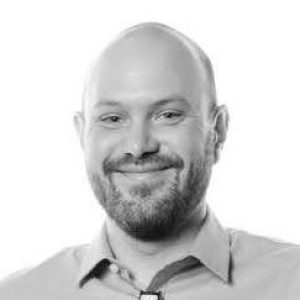





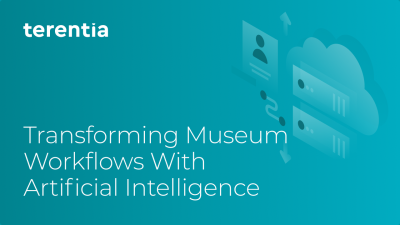
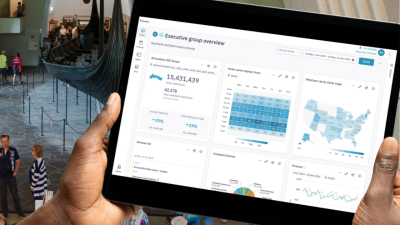
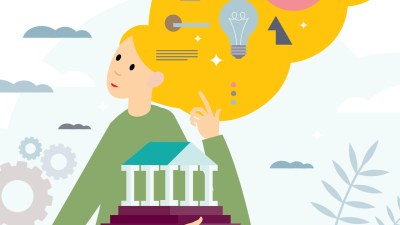
Comments